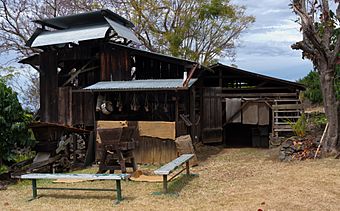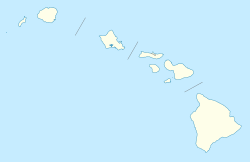Kona Coffee Living History Farm facts for kids
Quick facts for kids |
|
|
Uchida Coffee Farm
|
|

Historic coffee mill
|
|
| Location | Kona District, Hawaii |
|---|---|
| Area | 2 acres (0.81 ha) |
| Built | 1913 |
| NRHP reference No. | 94001621 |
| Added to NRHP | February 9, 1995 |
The Kona Coffee Living History Farm is a special place on the Big Island of Hawaiʻi. It's located in the Kona District, on what was once the Daisaku Uchida Coffee Farm. This historic farm, covering about 5.5 acres, started way back in 1900.
It's like an open-air museum where you can see what daily life was like for early Japanese immigrants in Hawaii. This period was between 1920 and 1945. The farm is in an area now called Captain Cook. However, in old Hawaiian times, this land was known as Kealakekua.
Contents
The Story of the Farm
Who Owned the Farm?
The farm was owned by a man named Daisaku Uchida. He came to Hawaii from southern Japan when he was 19 years old. That was on September 27, 1906. First, he worked for three years on a sugarcane plantation in Līhuʻe on Kauaʻi. After his contract ended, Daisaku moved to the Kona District.
Japanese Immigrants in Hawaii
Between 1868 and 1924, many Japanese workers came to Hawaii. More than 140,000 people arrived with work contracts for sugar plantations. Like Daisaku Uchida, many decided to leave the plantations. They started their own family businesses once their contracts were finished.
The Uchida Family Home
In 1912, Daisaku married his cousin, Shima Maruo. They moved to the farm in 1913. In 1925, they made the farm and their house bigger. The land itself belonged to the Greenwell family. Henry Nicholas Greenwell had been involved in the coffee business in the area since the 1870s.
The Uchida family lived on the farm for many years. Shima passed away in 1966 when she was 73. Daisaku lived to be 99, passing away in 1986. Three of their children were born in the original house. Three more were born in the new, larger house after 1925. Their oldest son, Masao Uchida, also farmed the land. He and his wife Masako retired to Honolulu in 1994.
Saving the Farm for History
The Uchida family's long-term lease on the land eventually ended. The area was planned to be turned into new homes. But because the farm had never been updated, it was special. Sherwood Greenwell, from the Greenwell family, decided to donate it. He gave the farm to the Kona Historical Society. This way, its history could be saved.
Visiting the Museum
What You Can See and Do
The Kona Coffee Living History Farm is a living history museum. This means you can explore it and imagine life in the past. You can take a self-guided tour of the coffee orchard, the farmhouse, and the coffee mill. There's also a kiosk for visitors.
Sometimes, you can even take a full tour with guides. These guides dress in old-fashioned clothes from the Kona Historical Society. They help bring the history to life! There is a fee to enter the museum.
Recognized as a Historic Place
The farm is very important historically. It was added to the Hawaiʻi Register of Historic Places on April 16, 1994. It's listed as site 10-47-7509. Then, on February 9, 1995, it was added to the National Register of Historic Places listings on the island of Hawaii. Its number there is 94001621.
The original Henry Greenwell Store is also a historic site. It houses the Kona Historical Society today. Both the farm and the store are located on the Mamalahoa Highway, also known as the Hawaii Belt Road.
See also
- Coffee production in Hawaii
- Coffee processing
- Open-air museum



